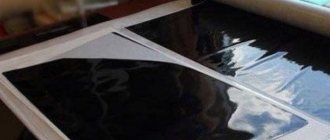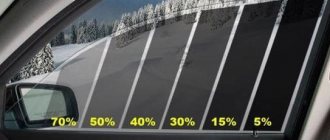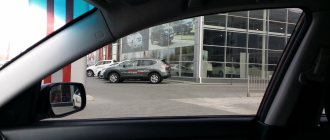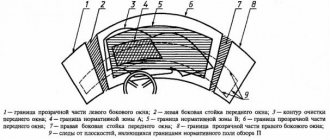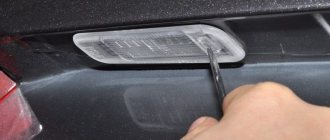New measures to combat excessive tinting
The State Duma is actively discussing increasing sanctions for darkening windows and headlights, which do not comply with traffic regulations. A new law is being prepared for adoption, according to which it is planned to significantly increase the fine and tighten other penalties for tinting with inappropriate light transmission. Thus, if all the amendments are adopted, then drivers should prepare for the following penalties:
- A threefold increase in the fine (from 500 to 1,500 rubles) for the first protocol.
- Fivefold increase in the amount of the penalty (from 1,000 to 5,000 rubles) for repeated violation
- Deprivation of a driver's license for a period of two months to six months for the third offense.
At the moment, the new law is only going through the stages of discussion and when it will be adopted (how and whether it will be adopted at all) remains a mystery. As mentioned earlier, as of July 1, 2018, the fine for tinting remains the same.
Actions of the vehicle owner
How to remove old tinting from glass yourself
There are several options, the most obvious is to bring the glass tinting to comply with state standards or simply remove the polymer film. You can stop using the car or sell it.
If the car owner does not intend to go to court regarding the illegality of determining the penalty in the form of a fine, then it is better not to delay, but to make payment within 20 days after the decision is made. In this case, the amount will decrease by 2 times, this provision is enshrined in Article 32.2, Part 1,3.
Otherwise, the punishment will remain in effect. If the judge nevertheless cancels the monetary penalty, then the order will automatically cease to be a legally valid document.
Prescription what is it
Fine for tinting in 2019
The order for tinting, if considered in the actual sense of the word, is interpreted by the Supreme Court and other law enforcers as a requirement consisting in stopping the commission of an unlawful act. The State Traffic Inspectorate, like other police departments, has the duty to demand the cessation of offenses of an administrative nature. Similar requirements are expressed in relation to an individual or legal entity.
The implementation of the stated rule is that an inspector, having seen someone illegally committing any action, must contact and demand that such activity be stopped. This sample cannot be used with tinting.
The technical regulations of the Customs Union stipulate that the tinting of the car hemisphere located at the front should not have a light transmittance lower than 70 percent. When traffic police inspectors check a car for the specified parameter with a special test and it shows a lower level, a fine will be applied to the driver. In this case, the resolution will be drawn up under Article 12.5 of the Administrative Code.
Currently, violation is punishable by a fine of 500 rubles
It is worth paying attention to the fact that it is illegal to sign the act in question in the case when the inspector “by eye” determined that the tinting of the car deviates from the established norm. In practice, the order can be appealed by filing an appeal to the court
Speaking about what to do if you have been issued a prescription for tinting, you should pay attention to the following:
- the actions of the traffic police officer complied with the law;
- if violations occur, go to court and appeal;
- If everything is according to the law, the tint will be removed.
When answering the question of how long the prescription for tinting is currently in effect, you need to refer to the current provisions of the law. The notice form will be issued to the motorist immediately after he has committed a violation of the legal provisions. It is mandatory to eliminate the violation reflected in the specified act. You can cancel the order by appealing or removing the tint.
The position of the courts on regulations and requirements for tinting
Most of the court decisions under Art. 19.3 of the Code of Administrative Offenses will concern something completely different from what is discussed in this article. For example, someone was kicked out of a room where the person had no right to be, and the police were called. The police demanded that he be kicked out, but he was not kicked out. They tied me up, took me to the department, took me to court, and issued an arrest under Article 19.3 of the Administrative Code.
As for Part 1 of Art. 12.5 of the Administrative Code - mostly fines of 500-1000 rubles. In reality, they put under arrest either those who are especially desperate, or those who argued with the judge and were insolent. If you have already been brought to court on an unfulfilled order, you have not even tried to appeal it, then the only reasonable way out is to tell a sad story that you worked too much and were very tired and simply forgot about this order. Then they will let you go with a fine. If you try to prove that you are Dartagnan, then it is easy to snatch and arrest. The corresponding practice is quite present.
If you don’t want problems and clarifications on tinting issues, it’s better not to stick it on at all... Look, the traffic police officers will turn into Uncle Styopa
But let's end this article on a good note. Not all traffic police officers work solely to make life difficult for ordinary motorists. Here is an example of sensible guys. I hope that in their free time from saving people they do not write out all sorts of illegal pieces of paper:
Instruments for measuring the light transmittance of glass
How to properly apply tint yourself
If a traffic police inspector decides to measure the light transmittance of your glass, you should ask him for a valid certificate for the device and see if the device itself is sealed. If the inspector refuses to show the certificate or if it is expired, you should move on calmly, since the measurement is simply impossible.
Often, measurements are made with a portable Blik device. It connects to the car's cigarette lighter and works correctly at a voltage of 12 volts (+- 0.6 volts). Tell the inspector that your battery is very weak and cannot produce the specified power, the inspector will have to drive his car and connect the device to it. The Blik device on its screen shows the amount of light transmitted, for example, if you see the number 75 on its screen, it means the light transmittance of your glass is 75%, which means everything complies with the technical regulations. It should also be remembered that this device can only be used at temperatures from -10 to +40 degrees Celsius. Measurements should be taken at three different points on the glass; the arithmetic average will be an indicator of light transmittance.
Important!
Be careful at all stages of measurement. If the inspector made a mistake somewhere, he should not point it out. After drawing up the protocol, simply indicate all the employee’s mistakes in the protocol itself, in this case it will be much easier to defend your rights.
How should car windows be shaped?
The legislative framework provides for a requirement for auto tinting. Such an act will be issued by a traffic cop. The requirements for tinting in a car are specified in GOST, developed under the number designation 32565-2013. This act is valid in 2018; earlier other provisions could have been applied.
The current law states that the following requirements are established:
- Glass must have a certain light transmittance. This applies to the front and rear side windows and windshield. The value is set to 70 percent.
- If there are two rear view mirrors, then light transmittance is not standardized. The main condition is that the driver is provided with a view of the rear view.
How long is the prescription for tinting?
The validity period of the order to remove the tint is indicated on the form. Most often, the inspector gives 10 days for this from the date of drawing up the document.
If, after its validity has expired, and the car owner is again detained in the same car as before, then the appropriate penalty described above will be applied to him.
The article: Mirror tinting will tell you whether mirror tinting is allowed on the rear window and rear side windows. Athermal tinting on the windshield, read about it here.
Another question concerning how long the ruling lasts (the limitation period) may also be of interest to many car owners who are faced with similar problems.
This is officially interpreted in the Code of Administrative Offenses of the Russian Federation, Art. 19.3 part 1, which is subject to another standard: Art. 4.5 of the Code of Administrative Offenses of the Russian Federation “Limitation of bringing to administrative responsibility.”
It contains the following entry: “A demand for an administrative offense shall not be issued after 2 months. If the case is considered in court – 3 months.”
The case with tinting will in any case be considered by the court (in the presence of the violator or without him), so the statute of limitations for this order is 3 months. Just below, the description of the article states that the calculation date is calculated from the moment the document (instruction) is drawn up.
How to check toning
Measurements to determine the light transmission of glass covered with tinting film are carried out in compliance with legal requirements. The procedure takes place at a stationary traffic police post by a specially trained employee using a taumer.
A device with a permissible error of 2% must meet the following conditions:
- be certified;
- have a certificate of annual verification, seal;
- contain a sticker on the body with the date of the last inspection;
- suitable for measuring glass of a certain thickness.
The exact percentage of light transmittance by tinting will be shown by the taumer if it is used at a temperature of 20 °C with an error of no more than 5 °C, air humidity 60% plus or minus 20%, pressure 86–106 kPa. An employee of the State Traffic Inspectorate must have measuring instruments for these parameters.
The device will work under other conditions, for example, in cold or rainy weather, but the readings will be distorted, which will give the driver the opportunity to appeal the inspector’s actions.
Since penetrating light rays are measured, not absorbed ones, the results are not affected by the time of day. For glasses larger than 7.5 mm, the “Blik+” and “Tonic” models are used. If the thickness is less, you can use “Light” and “Highlight”. Supply voltage is 12 volts with a permissible deviation of 0.6. The person using the device is not required to provide the driver with a certificate of verification; a plate with the date is sufficient.
Procedure:
- determine air temperature, humidity, pressure;
- prepare the glass, clean it, wipe it dry;
- take measurements with the device;
- present the obtained indicators to the driver.
When a tint film that complies with the technical regulations transmits light, a report is drawn up; if the percentage of penetrating light rays is less than the norm, then a protocol is drawn up indicating the evidence obtained, and then a fine is issued and a requirement to stop the offense.
Issuing an order for a violation detected visually is illegal. The Supreme Court of the Russian Federation put an end to this issue back in 2011, when it overturned the decisions of lower courts. The check must be carried out exclusively by measuring means.
Requirements for tinting
The Code of Administrative Offenses, effective in 2019, namely Article 12.5, Part 3.1, informs that the light transmission of glass must meet technical requirements, otherwise a fine will be imposed.
The standard for tinting the remaining windows is not determined, provided that the rear view mirrors are installed and working in the car. This also applies to the permitted 14-centimeter strip of the windshield located on top; its light transmission is not adjustable.
Rosstandart defined glass painted or with a polymer film as light heat-protective.
Mirror tinting is still prohibited.
In the Stavropol Territory, if a driver ignores the traffic inspector’s demand to remove the tint, he faces 15 days in the penitentiary for disobedience.
Anyone who looks at the road through tinted windows can see the checkered sky. At least in one Russian region. In the Stavropol region, motorists were obliged to come out of the darkness. If the driver ignores the traffic inspector’s request to remove the tint that does not comply with GOST, he faces 15 days in the correctional facility for disobedience to a police officer.
NTV correspondent Maxim Berezin looked at this new experience from two sides.
Will you be removing this tint on site? It's a shame to take it off, look how beautiful it looks! Looks good.
Tinting film in the Stavropol region is now strictly illegal, even against the backdrop of other seemingly more serious driving mistakes, this violation acquires a certain odiousness. It all started when one of the drivers, who habitually refused to remove the film from the windows, unexpectedly found himself behind bars. He spent exactly 24 hours in the cell.
Igor Semenov, deputy head of the road patrol department of the State Traffic Safety Inspectorate of the Main Internal Affairs Directorate for the Stavropol Territory: “In the city of Stavropol, measures were taken in the form of administrative arrest for failure to comply with the demands of police officers. I can say that it had a very effective effect, because after making such a decision, people began to strip the vehicle on the spot.”
The raid begins in the morning in several districts of Stavropol. The police are armed with light-measuring devices with the cheerful name “Tonic”. They help determine the compliance of the film with GOST on the front windows. Almost no one gets tested.
Motorist: “You’ll have to go to court, where, based on the judge’s decision, a fine of 500 to a thousand or arrest for up to 15 days.”
The risk of ending up in the bullpen due to the tint not being removed on time is indeed very high. The police refer to federal law, more precisely, to Article 19.3 of the Code of Administrative Offenses, which provides for liability for disobedience to a police officer.
A driver caught driving a tinted car is usually asked to remove the film on the spot. In case of refusal, a requirement is issued to eliminate the technical malfunction, which the film is considered to be within one day. Falling into the hands of the traffic police again is regarded as ignoring the demands of the police officers, and, most likely, will end in the Magistrate's Court.
In the Caucasus, where black car windows are almost a national tradition, the zeal of the Stavropol traffic police, of course, produced a powerful effect. Motorists were not even puzzled by the new rule, but seriously frightened. However, no one is in a hurry to remove tinting from windows en masse: when driving past checkpoints, it is much easier to respectfully lower the windows, hoping that no one will notice. All that remains is to wait for bad weather and see what else the driver's ingenuity is capable of.
In fact, it was not the Stavropol residents who were the first to carefully read the administrative code, but the traffic police of the Mari-El Republic. It was there that the lover of dark glass was first put in jail. The angry driver went through the authorities, eventually reaching the Supreme Court of Russia. The court, however, recognized the policemen’s actions as justified, and a precedent arose.
Alexey Selyukov, Commissioner for Human Rights in the Stavropol Territory: “I think this is a misunderstanding of the law. I believe that one cannot be deprived of freedom for this. Well, okay, they deprived him of it for 10 days, served it, didn’t do it again, what then?”
There is already an opinion among drivers that under the new rule a person will be punished twice for the same offense. The first time is when they issue a fine for tinting, and the second time when a day later they catch you again for the same reason. But the whole point, it seems, is in the educational effect of the law. After several arrests, police officers expect that drivers will begin to be more respectful of traffic police regulations.
Car enthusiast Alexander Morev seems to have been imbued with this feeling for the rest of his life; he spent almost the entire day in heated debates with the police, and in the evening he still ended up in court.
Alexander Morev: “We’ll tell you, we’ll show everything to our friends and comrades and we’ll tell them not to violate it.”
Alexander still got off happily. He will pay a minimum fine of 500 rubles and, most likely, will never tint his Lada again, which, apparently, cannot be said about larger cars.
Traffic police officer: “People don’t stop thinking too highly of themselves.”
Is it possible to rip off and avoid the requirement?
If the light transmission of the glass does not meet the requirements of the Technical Regulations, then the event of an offense under Part 3.1 of Article 12.5 of the Code of Administrative Offenses is established, and either a protocol is drawn up against the driver or an order is immediately issued.
But the policeman has a question: should a driver with tinted windows be released? After all, he will continue to violate the requirements of the law, and such management in itself is unsafe.
To commit an offense, there must be reasons and conditions. In our case, the reason is the application of a tint film. But window tinting in itself is not an offense. For an offense to take place, the driver only needs to start driving. Starting to move, that is, driving a car, is a condition for an offense.
To eliminate the conditions of the offense, the driver with tinting is issued a so-called “Demand to eliminate the conditions leading to the offense.” In itself, such a requirement is illegal - it replaces a warning. But the practice of punishing for failure to comply with the requirement to terminate management in the courts has become established.
In order to avoid having to issue such a paper to the driver, most often in practice in 2021 it is enough to remove the tint from the windows yourself on the spot.
Something else useful for you:
- Is it legal for a traffic police inspector to demand that he get out of the car?
- Requirement for tinting: how to remove it and is it legal?
- Suspension from driving a vehicle in questions and answers
Procedure
Requirements
If you do not know what the requirement for tinting is, it is confirmed by a document that is issued once. If the driver ignores this condition, then at the next stop the police inspector will fine him 500 rubles, and also impose an additional punishment. It is chosen by the judge. The outcome of the simplest option is a fine of up to 1,000 rubles. Sometimes an administrative arrest may be imposed for a period of up to 15 days. In fact, there are drivers who are willing to constantly pay money for such a punishment, just so as not to dismantle the film from the front and windshields. Such punishment is designed just for such drivers. Few people want to sit behind bars for 15 days.
Tint Prescription Law
The order to remove the tint is considered an optional document that is provided to the driver together with the decision to impose the current administrative fine. In addition, it is necessary to indicate that the driver must remove it within 10 days, otherwise he will be subject to an additional article of the Code of Administrative Offenses, up to and including arrest for a period of 15 days. If you are wondering if the 2021 tint requirement is legal, it is, but the vehicle owner has the right to ignore it.
Validity period of the order
As mentioned above, the validity period of such a document is 10 days. But there are exceptions that are also taken into account in the Code of Administrative Offences. If during this time he does not comply with the requirements that were prescribed by the police inspector, the owner of the car will receive an appropriate punishment. To prevent this, try to fulfill all requirements and be an exemplary owner of the vehicle.
How to avoid a tint ticket?
If you have been issued a fine for tinting with a prescription, the optimal solution would be to remove it from the front windows of the car and bring it into compliance with the appropriate technical regulations of the Customs Union. Don't worry about any penalties, they will be eliminated in the future. There is no way to avoid being discharged. You can only ignore this document.
How to cancel a tint order?
Some unscrupulous owners are trying to find flaws in the law. Many people have a question about how to appeal a tinting order and whether it is possible to remove it, use the vehicle for a while, and then put it back in place. In this case, you will not be able to improve anything. The traffic police officer does not demand that the tint be removed, but asks not to violate the code of administrative responsibility. Driving practice shows that if you repeatedly drive a tinted car, the court goes over to the employee’s side. That is, the driver of the vehicle may be arrested or receive additional restrictions on operating the vehicle. Therefore, you don’t think it’s easy to appeal a tinting order.
However, the court cannot be on the side of the traffic police if the paperwork was completed with violations. If you find significant errors in the protocol, contact the court.
Is it legal
The legality of issuing such a paper can be understood from a detailed analysis of the current situation:
- First of all, there is no direct requirement in the document to remove the tint. It states that the driver must suspend the administrative violation. If you think logically, he can do this by performing any of 3 actions:
- remove the film;
- do not use a car;
- get rid of it (sell, donate).
- The inspector has the right to present the violator with a requirement to remove the tint, in accordance with the Federal Law “On Police”, Art. 13.
- The driver’s liability is provided for in Article 19.3 of the Code of Administrative Offenses, Part 1, “Disobedience to the legal request of a police officer.”
It follows from this that if the violator ignores the order and continues to drive a vehicle with glass that does not comply with GOST, at the next meeting with the inspector, he will receive a fine under clause 3 of Art. 12.5 of the Code of Administrative Offenses of the Russian Federation “Driving a vehicle in the presence of a malfunction or a condition that does not allow its use” in the amount of 500 rubles. and additional punishment stipulated by Article 19.3 of the Code of Administrative Offences.
In this case, the amount of secondary punishment for failure to comply with requirements is determined in court, that is, the decision is made by a magistrate.
The situation may end like this:
- A fine of 500 – 1,000 rubles. , in the presence of mitigating circumstances.
- Administrative arrest for 15 days.
It should be added that the following are considered mitigating circumstances in this situation:
- Voluntary removal of tint.
- Assisting the police officer in determining the conditions of the violation.
- Preventing negative consequences resulting from a violation.
- Voluntary compliance with the requirements of an order before it is issued.
Due to the fact that the amount of the fine is small, there are many drivers who are ready to pay them at a certain interval. They categorically refuse to remove the tint.
This is what the measure of deprivation of liberty is intended for. The argument to spend 2 weeks in captivity leads to the fact that the film is removed from the car.
Solutions for the owner of a tinted car
Speaking about whether it is legal to impose tinting orders on a car owner, we can easily answer in the affirmative. This act has a separate expression. No extract is made from it. It is issued after the inspector has drawn up a protocol documenting information about the commission of an offense. The action is implemented in accordance with the provisions reflected in Article 12.5 of the Administrative Code.
The legislator sets the period within which the order must be executed. The period of time will last, as a rule, ten days. If on the eleventh day the violation has not been eliminated and the inspector checks the car again, the provisions of Articles 19.3 or 19.5 of the administrative law may be applied to the violator. To get rid of the tinting film is required in a special company; after the procedure is completed, the owner of the car is issued a corresponding certificate.
Also speaking about how much the requirement for tinting applies, it is worth pointing out that traffic police officers, after stopping a car with a tinting violation, cannot independently tear off the film, since the violation is corrected by the car owner. The owner of the car has the authority to tear off the film at the place where his employee stops, but in this case the decision to impose a fine will not be canceled and it will not be possible to avoid responsibility.
Only half of the fine amount will be stored for the first twenty days after the violation, that is, you can pay it at a discount. If you do not make payments for a long time, then in addition to the fine itself you will have to pay accrued penalties. The resolution will usually be written by hand. There are many such cases in practice.
During verification activities, the police officer is guided by:
- The provisions of the Constitution. In particular, human rights must be respected.
- Police legislation.
If a violation is committed, the measure taken is considered illegal. It is possible to mitigate the punishment applied to the offender. Such provisions are enshrined in Article 4.2 of the administrative law. These include situations when a person voluntarily stops committing actions that violate the law. The violator also helps the inspector in establishing all the circumstances of the violation.
About the duration of the prescription
In general, as such, there is no validity period for such paper for tinting at all. The deadline specified in it is important to us. And it, as a rule, is written in the prescription or requirement itself (hereinafter we will use both terms, since in essence their meaning is the same). But often traffic police inspectors may not write deadlines at all.
The most common deadline is 10 days. During this time, you must detonate in order for the order to be fully complied with. Otherwise, the driver may be prosecuted under Article 19.3 of the Administrative Code, which provides for up to administrative arrest for up to 15 days.
If the validity of the order is not indicated on paper, then it is indefinite and never expires. If you are repeatedly caught tinted within six months, a year, 10 years, and so on, then they will be able to attract you under 19.3 in any case. Unfortunately, this is the practice.
Rules for determining the degree of tint
The procedure for measuring the degree of light transmission through the side windows of a car has its own characteristics. Necessary conditions for taking measurements:
- Light transmission measurements can only be taken at a stationary traffic police post;
- The devices with which measurements are taken must have appropriate certificates of conformity with the date of the last inspection indicated (that is, the device must be suitable for use). In addition, the device used must be included in the State Register of Devices Allowed for Use in Measuring Light Transmission. Some devices are prohibited from being used at subzero air temperatures outside, that is, in freezing temperatures.
- The measurement must be carried out by a traffic police inspector, provided that the glass is clean and dry.
Simply put, no free-standing traffic police inspector has the right to measure light transmission in rainy weather.
In addition, when carrying out it is necessary to pay attention to the external condition of the device, since some unscrupulous inspectors may stick small pieces of film onto the sensors, which naturally leads to measurements not in favor of the driver. There must also be a seal on the device itself.
But, if the inspector nevertheless made a measurement, then the driver has the right to demand a re-measurement. In this case, a prerequisite is the presence of two witnesses, who must be attracted by the inspector himself. If there is a clear delay in finding witnesses, then you can threaten the inspector with a call to the police, since he is violating the time frame for detaining the car.
Another important nuance: if the inspector made any mistake during the measurement, then you should not point it out to him. It is better to wait for the protocol to be drawn up and make a reference to the mistake made in it. In the future, this fact will help in defending your rights.
Responsibility for tinting
Initially, when tinting windows in our country, attention was paid not to the ability to reduce the flow of incoming light, but to limit the visibility of what was happening inside the car from the outside. This method was used for drinking alcoholic beverages, transporting passengers in larger numbers, and for committing and concealing traces of crimes.
This article is a reference to the Technical Regulations of the Customs Union 018/2011 “On the safety of wheeled vehicles” and updated in accordance with it GOST 32565-2013 “Safety glass for land transport. Technical conditions".
To avoid an increase in the number of accidents, traffic police officers are authorized to draw up protocols when conducting random checks on the streets of the city and beyond. If this fact is discovered, the result is the issuance of a resolution on the commission of an administrative offense and the imposition of a fine.
Legality of traffic police actions
Before issuing a monetary penalty, it is not enough to visually determine that the car does not look in accordance with the state standard. An employee of the State Traffic Inspectorate must check the light transmission with a special diagnostic tool under appropriate conditions.
If the driver sees any violations in the measurements, he may request the drawing up of a protocol in which he must indicate why the car owner does not agree with the results of the inspector’s actions. This document must be certified by two individuals as witnesses.
It is advisable to record everything that happens with a recorder or other photo and video devices. If you appeal the fine in court, the filming materials will be useful.
The possibility of this document is enshrined in Article 13 of the Law “On the Police,” which states that an official may demand that a citizen stop illegal actions.
The order is issued not only to the owner, but also to the person driving a particular vehicle. If this citizen is stopped a second time, but while driving a different car, then it is legal to take action against him as for the primary violation.
If the car owner is stopped outside a stationary post, or has received an invitation to proceed to it, then the driver has the right to refuse. Administrative detention is permissible only for repeated violations.
In court proceedings, you can prove your case if you are prompted to act illegally, get rid of the polymer tinting film at the stop.
Types of liability for violation of glass light transmittance
According to traffic regulations, car windows must meet certain technical parameters. And tinting is something that is prohibited by the current rules for the safe operation of vehicles. Therefore, the owner of the car must be punished for his actions. The Code of Administrative Offenses provides for a sanction in the form of a monetary penalty. Size – 500 rubles.
You will have to pay that much only for the primary violation. In this case, the inspector, at his discretion, can limit himself only to the protocol and a fine. But he can also issue a written order obliging the subject to eliminate the violation, that is, tinting.
If a citizen does not comply with the instructions, he will be required to pay 1,000 rubles to the budget. But they can also even restrict freedom for a period of up to 15 days.
Types of penalties for illegal car tinting
Most of the penalties provided for violations of GOST 5727-88 are prescribed in part 3 of article 12 of the Code of Administrative Offenses of the Russian Federation. This is what all law enforcement officers who catch a violator with illegal tinting are guided by. For all types of violations (reduced light transmittance of windshields and windshields, excessively increased width of the sun strip, use of mirror film) the same set of sanctions is provided, namely:
- A fine of 500 rubles. This amount is made legal by the corresponding resolution, which regulates the 12th article of the Code of Administrative Offenses. It is worth noting that a fine is the most common way to punish the driver of a vehicle with illegal tinting.
- Order for illegal tinting. Despite the fact that the possibility of issuing such an order to the driver is not regulated by Article 12 of the Code of Administrative Offences, quite a large number of law enforcement officers still practice this action. This kind of order contains a requirement to eliminate the source of the violation, that is, illegal tint film. At the same time, in accordance with the same regulation, the owner of the vehicle undertakes to remove the film within one day from the date of receipt of such a document.
For violation of the law on tinting, the film is removed on the spot.
Administrative arrest. This penalty is directly related to the sanctions from the previous paragraph. According to the law (namely, Article 19 of the Code of Administrative Offenses), if a car owner who received an order for illegal tinting did not eliminate it within one day, this can be regarded as resistance to law enforcement agencies. Accordingly, if state traffic inspectors have detected illegal tinting of a vehicle, the owner of which received an order more than a day ago, they can punish him in the form of administrative arrest for a period of 15 days, and this will be absolutely legal.
Nowadays, many motorists still mistakenly believe that illegally tinting a vehicle can result in license plates being removed. This is wrong.
Thus, if a state traffic police officer threatens to remove your license plates because of incorrect tint, this can be safely regarded as a false accusation and subsequently used in court.
Protocol for incorrect tinting.
How to avoid a fine for tinting?
From the established practice of operating vehicles with tinted windows, the following aspects must be taken into account:
- In most cases, courts support the traffic police when reviewing fines.
- When considering cases, one of the parties often requests a re-examination.
If a car is stopped by a traffic police inspector for improper tinting, the driver must:
- Carry out a detailed recording of all actions of the inspector.
- Record the process of measuring glass tinting.
- Check the device used by the inspector for the presence of mandatory seals and a certificate.
Based on the collected material, it is possible to identify discrepancies between the actions of the traffic police inspector and current legal norms and challenge the issued fine in court.
Compliance with tinting standards allows you to avoid fines. Proper tinting creates comfortable conditions for passengers in the cabin and reduces the need for air conditioning. Protects the upholstery of the cabin and seats from bright sunlight, preventing the seats and instruments from heating up.
In addition to window tinting, lighting fixtures can be tinted. But it must be taken into account that headlights and side lights must comply with the requirements of the regulations corresponding to passenger cars.
Didn't find the answer to your question? Find out how to solve exactly your problem - call right now: +7 (Moscow) +7 (812) 309-53-42 (St. Petersburg) It's fast and free!
Free online consultation with a car lawyer
Didn't find the answer to your question? Find out how to solve exactly your problem - call right now: +7 (Moscow) +7 (812) 309-53-42 (St. Petersburg) It's fast and free!



